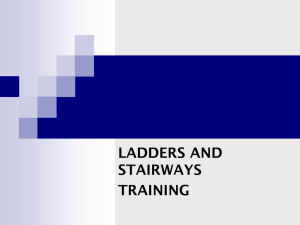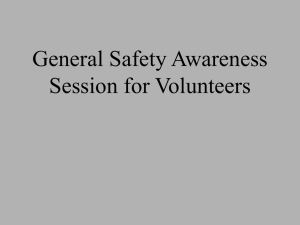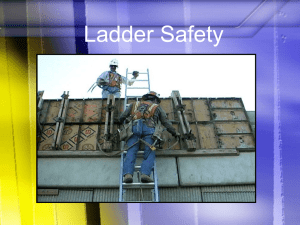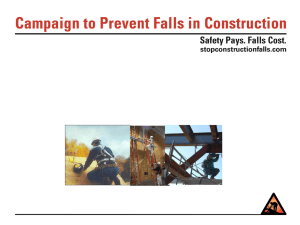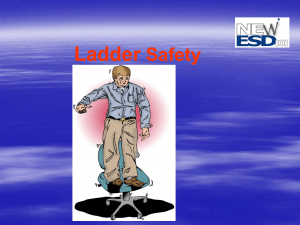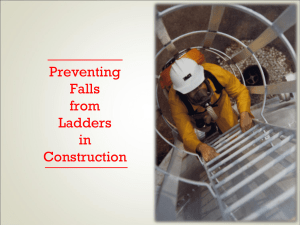Subpart X Ladders and Stairways 29 CFR 1926.1050
advertisement
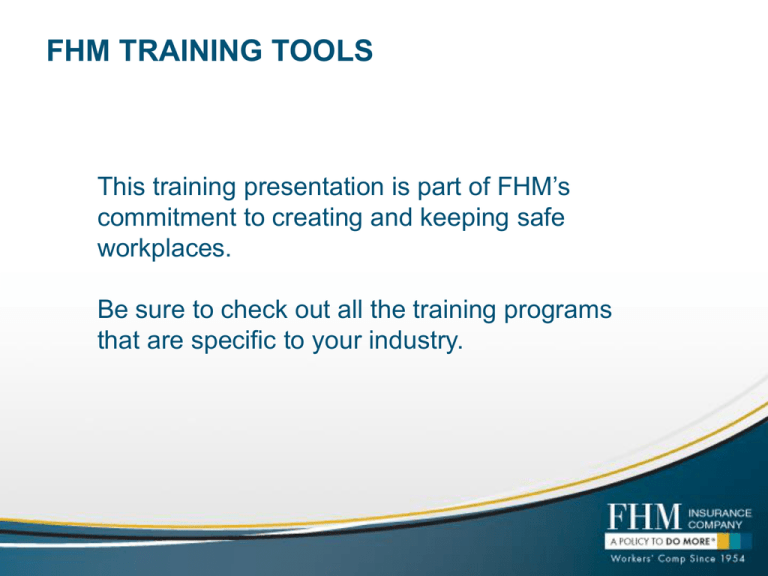
FHM TRAINING TOOLS This training presentation is part of FHM’s commitment to creating and keeping safe workplaces. Be sure to check out all the training programs that are specific to your industry. Ladders and Stairways OSHA Standard General Requirements: 29 CFR 1926.1051 • A stairway or ladder must be provided when there is a break of elevation 19 inches or greater. • Spiral staircases shall not be used unless it is part of the permanent structure. • Passageways must be clear if it is the only means of access or egress on any working level. General Requirements (Cont’d) • • When work is required to be done in the access/egress area, another means must be provided for the employees to exit and/or enter. A Double-cleated ladder or two or more separate ladders must be provided when there are 25 or more employees on any working level. Stairways 29 CFR 1926.1052 • Stairway Requirements: – Temporary stairways must have 30 inch landing in the direction of travel and 22 inches wide every 12 feet. – Riser height and tread depth must be uniform and variations must not exceed 1/4 inch. – Stairways must be installed between 30 and 50 degrees from horizontal. Stairway Requirements (Cont’d) – A platform must be provided when doors or gates open into the stairways. – All parts of the stairway system shall be free from hazardous projections. – Metal pans must be filled prior to use. – Slippery conditions must be eliminated prior to use. Handrail, Stairrail and Midrail Requirements • Stairrail Requirements: – Stairrails are required when there are 4 or more risers or an elevation change of 30+ inches. – The height of stairrails must be: • • 36 inches installed after March 15, 1991. Between 30-34 inches before March 15, 1991. Handrail, Stairrail and Midrail Requirements (Cont’d) • Midrail Requirements: – Midrails must be installed midway between the steps and the top rail. – When screens or mesh are used as a midrail, they must extend from the top rail to the floor. – Vertical members used as midrails must not exceed 19 inches between members. Handrail, Stairrail and Midrail Requirements (Cont’d) • Handrail and Starrail Requirements: – Must be able to withstand 200 lbs force applied in any direction. – Must be separated from the wall by at least 3 inches. – Must have a safe surface. – The ends cannot be a projection hazard. Ladders 29 CFR 1926.1053 • Ladders must be able to hold the following loads without failure: – Self-supporting and non-self supporting portable ladders. • Must be able to withstand 4 times the maximum intended load. (3.3 for extra heavy duty ladders) Ladders Loading Requirements (Cont’d) • Fixed Ladders – Must be able to hold 250 lbs on two consecutive rungs. Ladder Requirements • Ladder rungs must be spaced evenly. • Ladder rungs must be made out of a slip resistant material. • Ladders should not be tied or fastened together to provide longer sections unless it was designed that way. • Step ladders are required to have a locking spreader bar. Ladder Requirements (Cont’d) Wood ladders can’t be covered with any opaque material. • Ladder components should be surfaced to prevent injury. • Fixed Ladders • Fixed ladders should have one of the following safety devices installed if it extends above 24 feet: – Cage or well – Ladder safety devices – Self retracting lifelines *Refer to 1926.1053(a)(19-22) for specific requirements on fixed ladder safety devices. Use of Ladders (Cont’d) • Ladders should extend 3 feet above the landing surface. • A 4/1 ratio should be used to set up ladders. Use of Ladders (Cont’d) • Ladders should be maintained free from oil, grease, and other slipping hazards. • Ladders should not be loaded beyond the manufacturers intended loading capacity. • Ladders should be used only for the purpose it was designed. Use of Ladders (Cont’d) • Ladders should only be used on level and secure ground unless it is stabilized. • Ladders should not be used on slippery surfaces unless it is secured or it has slipresistant feet. • Ladders placed in areas where they can be displaced should be secured or barricaded. Use of Ladders (Cont’d) • The area around the top and bottom of the ladder should be kept clear. • Ladders should not be moved, shifted, or extended while occupied. • Employees working around electrical sources should use nonconductive ladders. • The top of a step ladder should not be used. Use of Ladders (Cont’d) • Ladders should be inspected by a competent person on regular intervals or after an occurrence that could affect its safe use. • Any ladder with structural defects should be tagged out of service. • Single-rail ladders should not be used. Use of Ladders (Cont’d) • When ascending or descending the ladder, the user should always face the ladder. • Employees should use at least one hand to grasp the ladder when ascending or descending the ladder. • Employees should not carry any items that may cause the employee to loose balance. Training Requirements 29 CFR 1926.1060 • • Training is required for all employees that use ladders and stairways. Training must be conducted by a competent person. The competent person must address the following items: – The nature of all hazards in the work area. – Procedures for erecting, maintaining, and disassembling the fall protection used. – The proper construction, use, placement, and care of stairways and ladders. – The maximum intended load of ladders – The standards.

